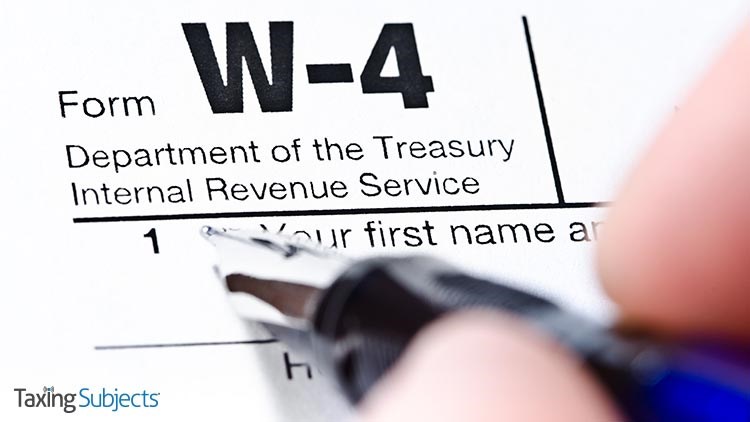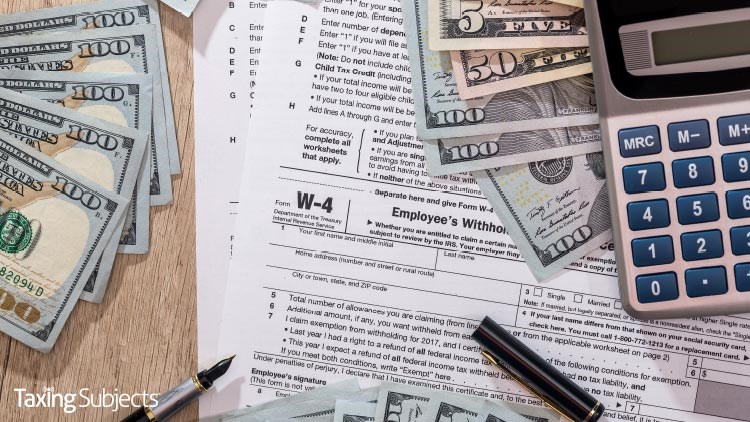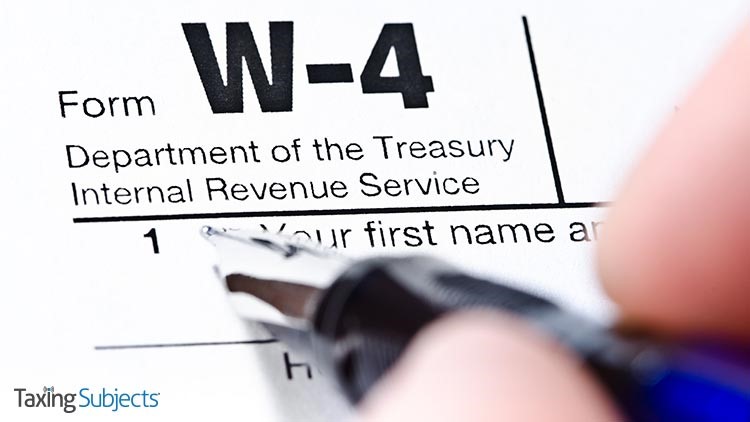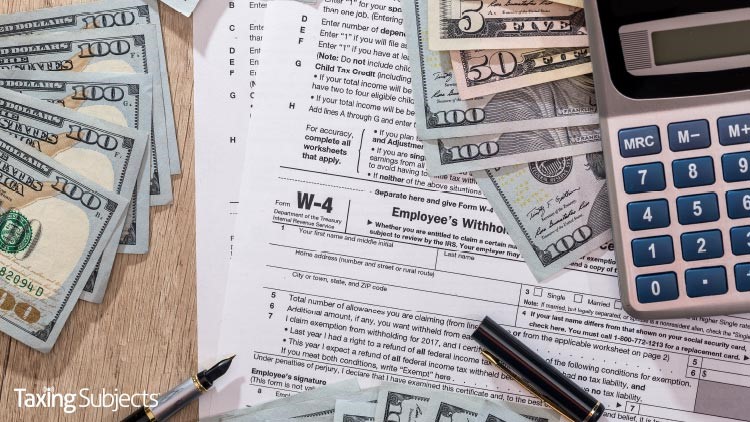
by r Hampton | Aug 21, 2019 | Tax News
A reworked version of Form W-4 has been released by the IRS and the Treasury Department for the 2020 tax year. A number of changes were made to earlier draft versions of the form in response to complaints from tax professionals.
Accounting Today reports Treasury doesn’t expect to make further changes beyond some small inflation-adjustment updates.
The redesigned Form W-4 uses a building-block approach, replacing complex worksheets with straightforward questions, making it simpler for employees to figure withholding accurately. The new form uses the same basic information as the old design, but employs a more personalized, step-by-step approach to better accommodate taxpayers.
Accounting Today reports the redesign will not force employees to resubmit a Form W-4 simply because of the update. Employers can continue to figure withholding based on information from the most recent W-4 submitted.
Complaints from Tax Pros
The complaints about the draft version of the form, Accounting Today reports, came from accountants and tax practitioners alike, who said the draft version required taxpayers to reveal too much information to their employers about outside sources of income for employees and their spouses.
The tax reform package passed in late 2017 eliminated traditional exemptions for taxpayers and dependents along with a long list of deductions, increasing the standard exemption amounts instead. The IRS urged taxpayers to do a “paycheck checkup” last year to make sure enough was being withheld from the taxpayers’ paychecks, but few taxpayers went through the complicated process. As a result, many taxpayers found themselves owing tax because of inadequate withholding.
The IRS is urging taxpayers to do another withholding checkup this year to make sure the correct amount is withheld from their paychecks. The agency has also come out with a new Tax Withholding Estimator online tool to help.
– Story provided by TaxingSubjects.com

by r Hampton | Aug 19, 2019 | Tax News
The Internal Revenue Service is warning taxpayers they risk losing their passports if “significant” tax debt is not paid. Those taxpayers are urged to contact the IRS immediately or have travel plans delayed later.
The passport action is mandated by the Fixing America’s Surface Transportation Act (also known as the FAST Act). The IRS is directed to notify the State Department which taxpayers owe a seriously delinquent tax debt of $52,000 or more. The law mandates that the State Department deny those taxpayers passport renewal or application for a new passport.
If a taxpayer currently has a valid passport, State may revoke the passport or limit a taxpayer’s ability to travel outside the United States.
Taxpayers who are certified as owing a seriously delinquent tax debt receive a Notice CP508C from the IRS that explains the steps needed to resolve the debt. IRS telephone assistors can help taxpayers with the options, such as setting up a payment plan or other measures.
The IRS says the important thing for taxpayers to remember is not to delay, since some resolutions take longer to set up than others.
No Time to Waste
Taxpayers with travel plans who have had their passport applications denied by the State Department need to call the IRS as soon as possible to resolve their tax issue and reverse the passport certification.
When expedited, the IRS can generally shorten processing time by 14 to 21 days from the normal 30 days. To qualify for expedited processing, taxpayers must inform the IRS they have travel scheduled within 45 days, or that they live abroad.
For expedited treatment, taxpayers must provide the following documents to the IRS:
- Proof of travel. This can be a flight itinerary, hotel reservation, cruise ticket, international car insurance or other document showing location and approximate date of travel or time-sensitive need for a passport.
- Copy of letter from State denying their passport application or revoking their passport. State has sole authority to issue, limit, deny or revoke a passport.
The FAST Act also allows the State Department to revoke a taxpayer’s passport at the request of the IRS. For example, the IRS may recommend revocation if the IRS had reversed a taxpayer’s certification because of their promise to pay, and they failed to pay. The IRS may also ask State to revoke a passport if the taxpayer could use offshore activities or interests to resolve their debt but chooses not to.
In cases of revocation, the IRS will send Letter 6152, Notice of Intent to Request U.S. Department of State Revoke Your Passport, to the taxpayer to let them know what the IRS intends to do and to give them another opportunity to resolve their debts.
Options for Resolution
There are several ways taxpayers can avoid having the IRS notify State of their seriously delinquent tax debt. They include:
- Paying the tax debt in full,
- Paying the tax debt timely under an approved installment agreement,
- Paying the tax debt timely under an accepted offer in compromise,
- Paying the tax debt timely under the terms of a settlement agreement with the Department of Justice,
- Having a pending collection due process appeal with a levy, or
- Having collection suspended because a taxpayer has made an innocent spouse election or requested innocent spouse relief.
Many times, taxpayers qualify for one of several relief programs to settle tax debts. One option is a payment plan, which can be requested by filing Form 9465. Taxpayers can download this form from IRS.gov and mail it along with a tax return, bill or notice. Taxpayers who are eligible can use the Online Payment Agreement system to set up a monthly payment agreement. Using the Online Payment Agreement system is cheaper and can save time.
In some cases, an offer in compromise can set up an agreement between the taxpayer and the IRS that settles the tax liability for less than the full amount owed. The IRS looks at the taxpayer’s income and assets to determine the taxpayer’s ability to pay. Taxpayers can use the Offer in Compromise Pre-Qualifier tool to help them determine whether they’re eligible for an offer in compromise.
Who Gets a Pass?
The IRS also will not certify a taxpayer as owing a seriously delinquent tax debt or will reverse the certification for a taxpayer:
- Who’s in bankruptcy,
- Who’s identified by the IRS as a victim of tax-related identity theft,
- Whose account the IRS has determined is currently not collectible due to hardship,
- Who’s located within a federally declared disaster area,
- Who has a request pending with the IRS for an installment agreement,
- Who has a pending offer in compromise with the IRS, or
- Who has an IRS accepted adjustment that will satisfy the debt in full.
It should be noted that the IRS cautions the above list is “subject to change.”
For taxpayers serving in a combat zone who owe a seriously delinquent tax debt, the IRS postpones notifying the State Department of the delinquency and the taxpayer’s passport is not subject to denial during the time of service in a combat zone.
For more on denying, revoking passports because of tax debt visit IRS.gov.
– Story provided by TaxingSubjects.com

by r Hampton | Aug 8, 2019 | Tax News
Ever had one of those days at work where things just didn’t seem quite right? Did you ever wonder if those little nagging problems might point to something larger – something like client data theft?
Since we’re between tax seasons, maybe now is a good time to brush up on the telltale signs that the office may have experienced a data theft that led to bogus tax returns being filed in your clients’ names.
The Internal Revenue Service and its Security Summit partners are taking this time to urge the tax community to review their data security protection. They’ve offered a “Taxes – Security – Together” checklist as a starting point. And knowing the warning signs of client data theft is Number 4 on the list.
Previous checklist items include: deploying the “Security Six” basic steps, creating a written data security plan and educating yourself on email phishing scams.
“Learning the signs of identity theft is critical for anyone handling taxpayer data,” said IRS Commissioner Chuck Rettig. “It can be as subtle as an unusually slow computer system or as obvious as multiple clients unexpectedly receiving the same IRS notice. Paying attention to these details is critical, and fast action alerting the IRS and calling in a security expert can help protect taxpayers and your business.”
No doubt about it, the Security Summit – made up of IRS and state taxing agency officials and tax industry partners – is making big progress against tax-related identity theft. But the fight is far from won. Cybercriminals are an agile lot and have learned to quickly evolve. So data thefts at tax professionals’ offices remain a major attack strategy. The stolen data is then used to create fraudulent returns that are harder for the IRS and its Summit partners to detect.
Signs of Client Data Theft
The IRS and Summit partners have created a list of warning signs that a tax professional or their office may have experienced a data theft:
- Client e-filed returns begin to be rejected by the IRS or state tax agencies because returns with their Social Security numbers were already filed;
- Clients who haven’t filed tax returns begin to receive taxpayer authentication letters (5071C, 4883C, 5747C) from the IRS to confirm their identity for a submitted tax return.
- Clients who haven’t filed tax returns receive refunds;
- Clients receive tax transcripts that they did not request;
- Clients who created an IRS Online Services account receive an IRS notice that their account was accessed or IRS emails stating their account has been disabled. Another variation: Clients unexpectedly receive an IRS notice that an IRS online account was created in their names;
- The number of returns filed with the tax professional’s Electronic Filing Identification Number (EFIN) exceeds the number of clients;
- Tax professionals or clients responding to emails that the firm did not send;
- Network computers running slower than normal;
- Computer cursors moving or changing numbers without touching the keyboard;
- Network computers locking out employees.
“Tax professionals should be on the lookout for these scary scenarios that have hit firms across the country, jeopardizing data of the company and their clients,” Commissioner Rettig said.
Because federal and state tax systems only accept one unique Social Security number, taxpayers often discover they are a victim when they attempt to e-file and their tax return is rejected because a return with their SSN already is in the system. More commonly, the IRS identifies a return that could be an identity theft return and sends a letter to the taxpayer asking them to contact the agency to let the IRS know if they filed the return.
Sometimes, the identity thief will attempt to leverage his stolen data by using the taxpayer’s information to access the IRS’ Get Transcript system. Such an attempt to create a fraudulent account will generate another warning sign: the two-factor authentication system used by Get Transcript will disable the account and send the taxpayer a letter to confirm their identity.
Taxpayers who get a transcript in the mail but did not order one are another warning sign that client data may be misused.
Check Your EFIN
One easy way to see if your client data may be compromised is to make a weekly check of returns filed under your office’s Electronic Filing Identification Number (EFIN). Tax pros can access their e-File applications and select “Check EFIN Status,” to see a count. The report is updated weekly. If the numbers are inflated, contact the IRS e-Help Desk at (866) 255-0654.
Another way to check is to log in to our Drake Support web site, select My Account, and go to the online E-File Database.
Check for acknowledgements for returns you didn’t e-file. Acks are usually sent soon after a return is transmitted.
Evidence Something’s Phishy
Tax pros who fall victim to “spear phishing” email scams may suddenly see responses to emails they never sent. If a practitioner is duped into providing username and password information to the thief, the cybercriminal often harvests the tax pro’s contact list, stealing names and email addresses of colleagues and clients. This further enables the crooks to use the tax firm to expand their scam.
Always be alert to phishing scams, even if the emails appear to come from a colleague or client. If the language sounds a bit off or if the request seems unusual, contact the “sender” by phone to verify rather than opening a link or attachment.
Finally, there are several signs that office computer systems may be under attack or may be under remote control, such as the cursor moving with no one at the keyboard. The IRS is aware of many examples where cybercriminals gained access to practitioners’ office computers, completed pending Form 1040s, changed electronic deposit information to their own accounts and then e-filed the returns – all performed remotely.
Tax professionals who notice any signs of identity theft should contact their state’s IRS Stakeholder Liaison immediately. The process for reporting data theft to the IRS is outlined in Data Theft Information for Tax Professionals.
– Story provided by TaxingSubjects.com

by r Hampton | Aug 6, 2019 | Tax News
The office tasked with overseeing the Internal Revenue Service says the agency hasn’t improved procedures enough when it comes to reviewing amended tax returns.
The Treasury Inspector General for Tax Administration carried out its audit to follow up on earlier TIGTA examinations that found risks of fraudulent or erroneous tax refunds from amended tax returns.
This latest audit used a sample of some 230 amended tax returns, taken from the total of more than 1 million amended returns the IRS processed in 2017. Auditors found 33 returns they labeled “questionable” with more than $74,900 claimed in refunds.
TIGTA estimates, based on the sample results, the IRS issued almost $360 million in potentially erroneous tax refunds that was claimed on over 158,000 amended tax returns in 2017.Using those figures as a guide, the audit forecasts the IRS could conceivably pay out almost $2 billion in erroneous refunds over the next five years.
The Breakdown
TIGTA’s audit found that of the 33 flagged returns, 23 came from employee processing errors that led to $58,204 in potentially erroneous tax refunds. The audit uses those 23 returns to extrapolate that similar employee processing errors cost the IRS some $279 million in refunds in 2017.
The audit report says the errors included:
- Tax examiners or the CSRs (Customer Service Representatives) erroneously allowed adjustments when the taxpayer did not include the required form with the amended return. These included returns in which tax examiners or the CSRs processed claims to change the taxpayer’s standard deduction to itemized deductions. However, the taxpayer failed to attach the required Schedule A, Itemized Deductions, to the amended return. Internal guidelines require that Schedule A be attached to the amended tax return to allow a change from standard to itemized deduction.
- Tax examiners or the CSRs erroneously allowed deductions to which taxpayers were not entitled. These included returns in which tax examiners or the CSRs allowed deductions for student loan interest when taxpayers claimed the deduction for a nondependent student. Student loan interest deductions are only available for individuals legally obligated to pay the loan, i.e., parents or other relatives cannot claim a student loan interest deduction if they are not legally obligated to make loan payments.
- The CSRs did not forward amended returns to the Examination function when required. These included returns with claims for a reduction in Net Investment Income Tax that was over the specified threshold. Internal guidelines state that when claims meet specific criteria, they must be routed to the Examination function for review.
- Tax examiners or the CSRs erroneously adjusted credits on associated taxpayer tax accounts. These included returns in which the tax examiner or the CSR incorrectly adjusted a refundable tax credit that the taxpayer neither requested nor was entitled.
TIGTA found that the 10 remaining questionable returns that did not involve employee error would have been caught and rejected by existing e-file software if amended returns were filed electronically.
Accounting Today reports that the Inspector General has recommended in years past (previous audits went as far back as 2012) that the IRS change Form 1040, allowing taxpayers to amend their original tax returns using the same form. TIGTA also has recommended that electronic filing be enabled for amended returns, saving over $17 million in processing costs.
While disagreeing with the recommendation at the time, the IRS said it would consider changing the Form 1040X to include data related to income changes along with moving toward e-filing of amended returns.
Recommendations
The Inspector General makes a number of recommendations to the IRS, including:
- Review the 23 questionable amended tax returns identified and take the actions needed to ensure taxpayers receive only the benefits to which they are entitled.
- Implement adequate processes and procedures to identify and correct employee errors to reduce erroneous refunds issued.
- Complete a business case and request funding for expansion of e-filing to amended returns in the 2020 Filing Season in an effort to reduce unnecessary processing costs and erroneous refunds resulting from amended returns.
- Update processing procedures to hold the amended tax return from further processing when the taxpayer’s tax account.
The IRS agreed with most of TIGTA’s new recommendations, but disagreed on the need to hold amended returns until the taxpayer’s identity could be confirmed in cases of identity theft. Agency management claimed that existing controls already provide adequate protection.
– Story provided by TaxingSubjects.com

by r Hampton | Aug 4, 2019 | Tax News
The IRS is joining with its Security Summit task force to warn tax professionals about the continuing threat posed by phishing emails to their data security efforts. Despite best efforts, phishing remains the most common tactic used by cybercriminals to steal sensitive data.
IRS Commissioner Chuck Rettig urges tax pros to take time during the summer months to review their data security measures.
“You can take all the cybersecurity steps in the world, but tax professionals and others in the business world should remember you are only as safe as your least educated employee,” said Rettig. “Cybercriminals use phishing emails and malware to gain control of computer systems or to steal usernames and passwords. These can provide a treasure trove of information that can lead to tax-related identity theft.”
A Common Start to a Shared Problem
More than 90 percent of all data thefts begin with a phishing email. Many times an employee opens a link that takes them to a fake web site or opens an attachment embedded with malware that secretly downloads onto their computer.
A variation on this theme termed “spear phishing,” uses bogus email messages posing as trusted source, meant to bait the recipient into opening an embedded link or an attachment. The email may make an urgent plea to the tax practitioner to update an account immediately. A link may appear to go to another trusted site – a cloud storage site or a tax software provider login page, for example – but it’s just another web page controlled by the thief.
Attachments may contain malicious software. One variety is called keyloggers; these small and nearly invisible programs secretly infect computers and provide the thief with the ability to see every keystroke. Thieves can then steal passwords to various accounts or even take remote control of computers, enabling them to steal taxpayer data.
The overarching characteristic of any phishing attack is deception. Some of the most common spear phishing scams seen by the IRS include thieves posing as prospective clients, sending unsolicited emails to the tax pro. After an exchange of emails, the thief sends a message with an attachment, claiming it contains tax information needed to prepare a return.
Instead, it actually contains spyware that allows the thief to track every keystroke.
More Than One Way to Steal
There are other scenarios, however, that could ensue from a phishing attack. The IRS also sees thieves posing as tax software providers or data storage providers with emails containing links that go to web pages that mirror real sites. The thieves’ goal is to trick tax professionals into entering their usernames and passwords into these fake sites, which the crooks then steal.
Sometimes the cybercriminal will encrypt the data rather than steal it. This is known as a ransomware attack.
Once they encrypt the victim’s data, thieves demand a ransom in return for the code to unencrypt the data. It should be noted that just because the cybercriminal is paid a ransom does NOT mean he’ll actually give the code to unencrypt your data. Many times the thief just takes the ransom and disappears.
Because of this, the Federal Bureau of Investigation warns users not to pay a ransom. The FBI says ransomware attacks are a growing threat to businesses and others.
How to Foil Phishing
Educated employees are the key to avoiding phishing scams, and office systems are only as safe as the least informed employee. These simple steps also can help protect against stolen data:
- Use separate personal and business email accounts; protect email accounts with strong passwords and two-factor authentication if available.
- Install an anti-phishing tool bar to help identify known phishing sites. Anti-phishing tools may be included in security software products.
- Use security software to help protect systems from malware and scan emails for viruses.
- Never open or download attachments from unknown senders, including potential clients; make contact first by phone, for example.
- Send only password-protected and encrypted documents if files must be shared with clients via email.
- Do not respond to suspicious or unknown emails; if IRS-related, forward to phishing@irs.gov.
The IRS and its Security Summit partners of federal and state tax officials and tax industry leaders, have issued a “Taxes – Security – Together” checklist to help remind tax professionals of the basic steps that can protect their data – and the data of their clients:
Publication 5293, Data Security Resource Guide for Tax Professionals, provides a compilation of data theft information available on IRS.gov.
– Story provided by TaxingSubjects.com

by r Hampton | Aug 1, 2019 | Tax News
Senate Finance Committee Chairman Chuck Grassley pushed Congress to revive the tax extenders that expired at the end of 2018 in a press release issued last month. Essentially a package of temporary tax breaks that are renewed every December, Grassley argues that failing to extend these provisions would hurt American taxpayers.
Injecting urgency into the tax extenders debate, the chairman invoked the specter of looming filing deadlines: “We are almost seven months after the end of 2018 and three months after the close of the regular tax filing season, and taxpayers still have no answer.” He believes that shrinking window translates to “millions of taxpayers … who are waiting on Congress so they can finalize their 2018 taxes and in some cases even stay in business.”
The majority of Senator Grassley’s press release was dedicated to trying to address two major concerns that have been raised about tax extenders:
- Tax extenders are merely tax breaks for major corporations
- Tax extenders were meant to be temporary tax breaks
To the first point, Grassley argued that thirty percent of the tax extenders budget goes toward “a deduction for mortgage insurance premiums and a provision that allows college students to deduct tuition and related expenses. They also include incentives for individual consumers to purchase energy-efficient products for their home, as well as certain types of alternative vehicles.” That said, Grassley admitted that the majority of the tax extenders budget is allocated for business incentives spanning a wide range of industries—from green energy to railroads.
As for those worrying about the cost of renewing temporary tax breaks every year, Grassley assured them that the Senate Finance Committee was investigating the issue: “I know that there are those who question the need to extend these provisions in perpetuity, and I agree with them. That’s why the Finance Committee created a series of task forces to examine these policies for the long-term.” The findings of those task forces were expected “later [that] week,” but those results have not yet been reported.
Do you believe Congress needs to renew the tax extenders that expired in 2018? Let us know in the comments below!
Source: “Grassley on Tax Extenders Benefits”
– Story provided by TaxingSubjects.com













 TAXTIMEKC
TAXTIMEKC